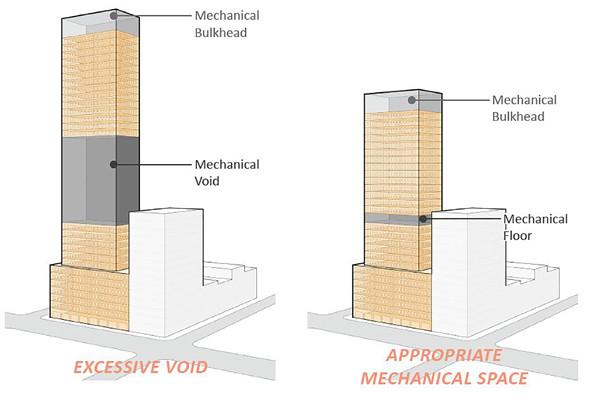Public Input Needed for Positive Change!
A public hearing to be held next Wednesday, March 13th at the City Planning Commission (CPC) marks the next milestone in the public review process for the Department of City Planning’s mechanical void proposal. This action stems directly from Mayor de Blasio’s response to the issue of zoning loopholes contributing to out of scale development, advocacy that was catalyzed by FRIENDS and fellow advocates at Town Hall meetings in 2018. For additional background, including a comparison of the two policy proposals currently on the table from both the City and the State, see HERE.
JOIN US TO SPEAK UP FOR YOUR NEIGHBORHOOD!
City Planning Commission Hearing on VOIDS Zoning Text Amendment
Wednesday, March 13th beginning at 10:00 am
120 Broadway, Concourse Level
Agenda HERE
Can’t make it in person? Send your comments to the CPC as outlined HERE.
The solution proposed by the Department of City Planning (DCP) takes a narrow view of this broad and wide-ranging issue, but it represents the first public attempt to reign in exploitation of zoning loopholes, and it is a positive, if incomplete, first step. Read DCP’s two-page description of the plan HERE.
FRIENDS supports the DCP proposal, but there is a critical need for modification in order to make it truly effective. Constructive public feedback now will also help inform the scope and content of DCP’s promised second action later this year.
As proposed, the DCP text limits only enclosed void spaces, and risks inadvertently incentivizing the use of unenclosed mechanical voids and stilts. Unless modified to remove the word “enclosed,” the proposal may not even impact the “barbell” building at 249 East 62nd Street, which features an egregious 150 foot void and galvanized FRIENDS’ and DCP’s work on this issue. This week, in response to a joint effort from a chorus of elected officials and FRIENDS, the Department of Buildings announced that it will require written review of the void condition from the Fire Department before the project can move forward. This referral to the FDNY is a step in the right direction, but the DCP proposal must also be amended to address this gaping loophole.
Furthermore, DCP proposed that in high density residential zoning districts and their equivalents (including First, Second, Third, and York Avenues on the Upper East Side) enclosed mechanical voids taller than 25 feet would count toward a building’s allowed floor area, and would count in their entirety if they are within 75 feet of each other. Though focused on residential buildings, the proposal would apply to some mixed use buildings as well. Though we understand DCP’s desire to establish limits while permitting design flexibility, 25 feet is overly generous for most mechanical needs, and allowing voids every 75 feet is far too frequent. All types of voids and stilts must be covered by this action, and the 25’/75′ thresholds should be significantly tightened.
While not a perfect solution, FRIENDS believes the Zoning Text Amendment is a critical first step. We plan to address our concerns with the proposal, including the senseless exclusion of unenclosed voids and stilts, the continued allowance of multiple exempt mechanical floors, and the seemingly arbitrary choice of 75 feet to prevent clustering.
Join us on Wednesday to make your voice heard!
Read More:
- DCP’s Full Zoning Text Amendment Application, Certified by CPC on January 28, 2019
- Summary of the proposal, with a map of impacted areas, prepared by Council Member Ben Kallos.
- “Plans for ‘condo on stilts’ halted over fire safety concerns, says DOB,” by Caroline Spivack, Curbed NY, March 8, 2019.
- “City drafts rules to crack down on height-boosting loopholes,” by Joe Anuta,
Crain’s New York Business, January 25, 2019.

Mechanical Voids Zoning Text Amendment Summary and Impact

249 East 62nd Street, which contains a 150 ft structural void.

